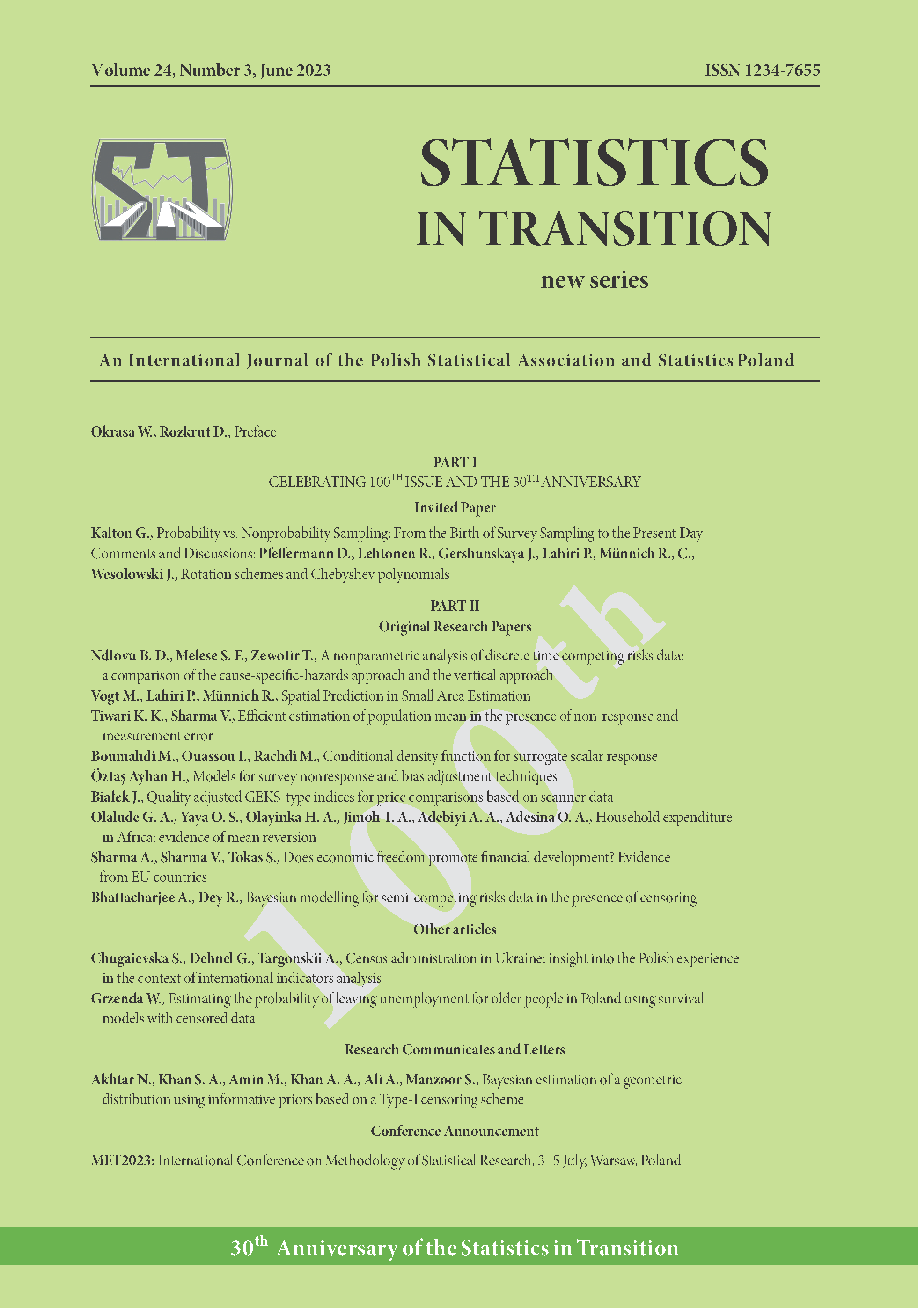ARTICLE
ABSTRACT
There is a continuing interplay between mathematics and survey methodology involving different branches of mathematics, not only probability. This interplay is quite obvious as regards the first of the two options: probability vs. non-probability sampling, as proposed and discussed in Kalton (2023). There, mathematics is represented by probability and mathematical statistics. However, sometimes connections between mathematics and survey methodology are less obvious, yet still crucial and intriguing. In this paper we refer to such an unexpected relation, namely between rotation sampling and Chebyshev polynomials. This connection, introduced in Kowalski and Wesołowski (2015), proved fundamental for the derivation of an explicit form of the recursion for the BLUE µ^t of the mean on each occasion t in repeated surveys based on a cascade rotation scheme. This general result was obtained under two basic assumptions: ASSUMPTION I and ASSUMPTION II, expressed in terms of the Chebyshev polynomials. Moreover, in that paper, it was conjectured that these two assumptions are always satisfied, so the derived form of recursion is universally valid. In this paper, we partially confirm this conjecture by showing that ASSUMPTION I is satisfied for rotation patterns with a single gap of an arbitrary size.
REFERENCES
Bell, P., (2001). Comparison of alternative Labour Force Survey estimators. Survey Methodology, 27, pp. 53–63.
Cantwell, P. J., (1990). Variance formulae for the composite estimators in rotation designs. Survey Methodology, 16, pp. 153–163.
Cantwell, P. J., Caldwell, C. V., (1998). Examining the revisions in monthly retail and wholesale trade surveys under rotation panel design. Journal of Official Statistics 14, pp. 47–54.
Ciepiela, P., Gniado, M.,Wesołowski, J., Wojty´s, M., (2012). Dynamic K-composite estimator for an arbitrary rotation scheme. Statistics in Transition, 13(1), pp. 7–20.
Fuller, W. A., Rao, J. N. K., (2001). A regression composite estimator with application to the Canadian Labour Force Survey. Survey Methodology, 27, pp. 45–51.
Gurney, M., Daly, J. F., (1965A). mutlivariate approach to estimation in periodic sample surveys. Proceedings of the Survey Research Method Section American Statistical Association, pp. 242– 257.
Hansen, M. H., Hurwitz, W.N., Nisselson, H., Steinberg, J., (1955). The redesign of the census current population survey. Journal of the American Statistical Association, 50, pp. 701–719.
Kalton, G., (2023). Probability vs. nonprobability sampling: from the birth of survey sampling to the present day. Statistics in Transition.
Karna, J. P., Nath, D. C., (2015). Rotation sampling: introduction and review of recent developments. Journal of Assam Science Society, 56(2), pp. 90–111.
Kordos, J., (2012). Application of rotation methods in sample surveys in Poland. Statistics in Transition, 13(2), pp. 243–260.
Kowalczyk, B., Juszczak, D., (2018). Composite estimator based on the recursive ratio for an arbitrary rotation scheme. Mathematical Population Studies, 25(4), pp. 227–247.
Kowalski J., (2009). Optimal estimation in rotation patterns. Journal of Statistical Planning and Inference, 139, pp. 1405–1420.
Kowalski, J., Wesołowski, J., (2015). Exploring recursion for optimal estimators under cascade rotation. Survey Methodology, 41(1), pp. 99–126.
McLaren, C., Steel, D., (2000). The impact of different rotation patterns on sampling variance of seasonally adjusted and trend estimates. Survey Methodology, 26, pp. 163–172.
Paszkowski, S., (1975). Numerical applications of Chebyshev polynomials, Warsaw (in Polish). Patterson, H. D., (1950). Sampling on successive occasions. Journal of the Royal Statistical Society, Ser. B, 12, pp. 241–255.
Rao, J. N. K., Graham, J. E., (1964). Rotation designs for sampling on repeated occasions. Journal of the American Statistical Association, 59, pp. 492–509.
Särndal, C.-E., Swensson, B., Wretman, J., (1992). Model Assisted Survey Sampling, Springer.
Singh, A. C., Kennedy, B.,Wu, S., (2001). Regression composite estimation for the Canadian Labour Force Survey with a rotating panel design. Survey Methodology, 27, pp. 33–44.
Steel, D., McLaren, C., (2002). In search of a good rotation pattern. In: Advances in Statistics, Combinatorics and Related Areas, World Scientific, pp. 309–319.
Steel, D., McLaren, C., (2008). Design and analysis of repeated surveys. Working Paper, Center for Statist. Survey Meth., Wollonong Univ., 11-08, pp. 1–13.
Szegö, G., (1959).Orthogonal polynomials, New York.
Wesołowski, J., (2010). Recursive optimal estimation in Szarkowski rotation scheme. Statistics in Transition, 11(2), pp. 267–285.
Yansaneh, I. S., Fuller, W., (1998). Optimal recursive estimation for repeated surveys. Survey Methodology 24, pp. 31–40.
